The history of cosmic rays - NUCLEON
Main menu:
- Home
- Science
- Experiment NUCLEON
- Current status
- Collaboration
- Education
- Publication
- Multimedia
Science
The origin mystery of galactic cosmic rays
A little history
The existence of penetrating radiation of extraterrestrial origin was discovered almost accidentally by the Austrian Physicist Victor Hess in 1912. The scientist was studying the ionization in gas, being in a closed vessel. It was assumed that the main ionization comes from the radiation of earth's surface. But when lifting the recording equipment with the help of balloon, he was surprised to find that the ionization rate at an altitude of 5 km had increased several times compared to sea level. The discovery was interpreted as follows: radiation comes from Space, easily penetrates through the atmosphere and the vessel walls and ionizing gas. Later this radiation was called cosmic rays (CRs).
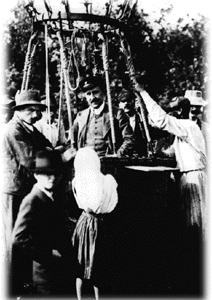
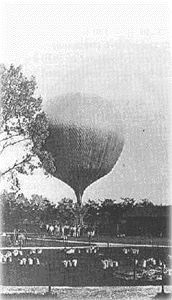
Photos from the launching site of installation,
by which cosmic radiation was discovered
Since that time, hundreds of scientists have tried to understand the nature of cosmic radiation, and it is known a lot at the present time. It was shown that cosmic rays is an atomic nucleus ingoing uniformly from all directions (isotropic) of surrounding space of Earth. The most intriguing feature of this radiation was a power-law distribution of particles at energy I (E) ~ E-, extending by many orders of power from 106 to 1020 eV (the energy of the particles is usually measured in units of electron volts: 1 eV = 1.6 10-12 erg, GeV = 109 eV and 1012 eV = TeV units will frequently occur). Scientists were able to determine that, cosmic rays have mostly a galactic origin to an energy ~ 1018 eV (Galactic CRs - GCR). And CR coming from other galaxies to Earth begin to dominate at high energies. In addition, the estimated density of CR energy in the galaxy was infinite ~ 1 eV / cm3. It’s comparable to the total density of electromagnetic radiation of stars in the galaxy, the energy of the thermal motion of interstellar gas and kinetic energy of its turbulent motion and energy density of magnetic field of the galaxy. It allows to consider that cosmic rays are the most important component of interstellar medium of the galaxy. And the determination of CR sources and the study of its spread process to Earth are ones of the most important tasks in astrophysics.
The first attempts to explain the GCR origin were made from the energy balance of the Galaxy. Supernovae bursts, probably the most powerful energy sources in our Galaxy, have been considered as such objects the last few years. But despite the long history of GCR research, their origin (especially in the field of high energy) does remains a mystery. Many issues have not received the answers. What are the facilities and how to accelerate cosmic rays in excess of energies at many orders of magnitude, that can generate particles from the grand thermonuclear furnaces – the interior of stars? Is there a single forming mechanism of particle streams or several various mechanisms, acting in different areas of energy? What energies does cosmic rays of extragalactic origin begin to dominate? The fracture presence (the abrupt change of power-law spectrum, used to call the “knee”) at energy ~ 3x1015 eV has not explained till now. It’s one of the mysteries in the CR spectrum, discovered in 1958. Many hypotheses have been proposed to explain the whole complex of observed data of GCR, but the overall picture remains unclear and contradictory in many ways.
To some extent, unsolved issue of GCR origin is the fact that these particles are electrically charged and spread from the source to registration place not in a straight line, but changing its original direction, deviating in magnetic fields of the Earth, the Sun and the Galaxy. That’s way we can not to register the GCR of low energies in the near-Earth space. They reflected by magnetic fields of the Earth. But the source of high-GCR couldn’t be observed in the way like we see the star too. The original direction is distorted by magnetic fields of the Galaxy. For this reason, the “rays” name couldn’t be successful, because the flow of GCR particles does not spread in a straight line.
If we study the light from a star, we register the photon flux with quite low energy ~ 1 eV, but modern technology allows to record photons with very high energies up above 1012 eV (photons at high energies used to call gamma quanta). According to the laws of nuclear physics, gamma quanta with energies above 1012 eV = 1 TeV can formed by charged particles with energies on the order of magnitude above - 1013-1014 eV during their interaction with the interstellar medium. It means that the GC acceleration place of high energies could be seen. Science that studies the galaxy in the streams of high-energy gamma quanta, called the TeV’s gamma-astronomy. It was originated in the 70s of the last century, and it was able to solve the problem of CR origin, as at seemed that time. But it hasn’t happened so far. Although several sources in the Galaxy, which formed with TeV’s gamma quanta, have been found (the shells of supernovae and pulsars).
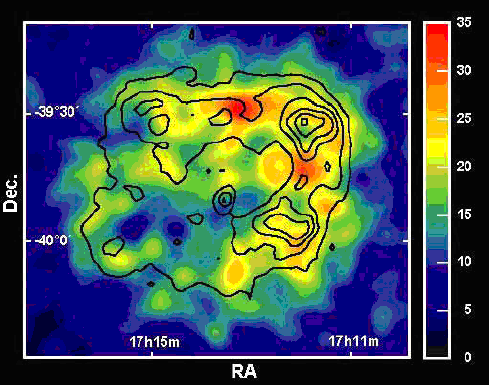
Possible acceleration place of CR spied by H.E.S.S. gamma-telescope (supernova remnant J1713.7-3946)
After analyzing the data from the N.E.S.S gamma-telescope – the most powerful at the moment, it has become clear that the CR origin problem is even more interesting than expected. For example, gamma- astronomy does not see sources of high-energy (> 1 TeV) gamma-quanta from all nearby supernovae remnants, but only from a small part, and the sources of gamma-quanta of MeV’s (1 MeV = 106 eV) and TeV’s energies are not the same (although the GCR range is power-law and continuous), and a variety of sources was very great. It remains to add that it was found several unidentified sources of gamma-quanta at a very high energy, including sources from our galaxy. The extended sources in the direction of the galaxy center have been discovered. These sources emit high-energy gamma-quanta and can not be seen either in the optical light or x-ray range. The authors called them "dark accelerators". That’s why it’s doubtfully that supernova is the only major CR accelerator in the galaxy.
The history of GCR research shows that only new experiments step by step, the installation by the installation, accumulate grains of knowledge about cosmic rays. It is highly may be that the mystery of CR origin still remains enigma, because we almost do not know anything about the fundamentals of matter and energy in the universe (dark matter and dark energy), as it has turned out in the last 10 years. Including the mass of dark matter in our galaxy, which is exceeds the known matter to us in many times over.
NUCLEON experiment is one of such experiments, aimed to measure the CR spectra in the area directly adjoining to the "knee" in the GCR spectrum. It will be shown below that the dependence of CR particles intensity from energy (CR energy spectrum) and the CR distribution on the charge and nucleus mass (chemical composition) contain important information about the CR sources, acceleration mechanisms and CR spreading in the galaxy.
The total energy spectrum of the GCR
Scientists faced with two major methodological difficulties in studies of GCR:
1. The primary flow of GCR does not reach the surface of the earth, even the surface of the highest mountains. Numerous interactions of particles and air atomic nucleus happen, as they entry into the dense atmosphere layers. Therefore, the study of GCR with "direct" methods (in which the energy and charge of the primary particle measured) is possible only outside the atmosphere, with the help of satellites or high-altitude balloons.
2.The CR intensity sharply falls with increasing of energy according to the I ~ E-2.7 law to the energy E ~ 3x1015 eV and to the I ~ E-3.1 law after this energy. For this reason, it is required the removal of apparatuses with a high aperture beyond the atmosphere for a long time for the research of particles with higher energies. Today the CR energies with “direct” methods, achievable in terms of spacecraft capabilities, are less than 1015 eV. Therefore, the representation of high-energy part of CR spectrum has received with "indirect" methods, especially with method of extensive air showers (EAS). The heart of this method is the registering of shower of secondary particles, generated with entering of the primary particle into the atmosphere, by virtue of the numerous nuclear and electromagnetic interactions of fast particles shower with nucleus and electrons of the atmosphere atoms. Each EAS has its own features on the composition of particles, their number, their spatial distribution, etc. The task for researchers is to make a “reconstruction” of the event, according to measured parameters of the EAS secondary particles. It means to move from the EAS parameters to parameters of the primary particle.
If we can try to achieve the energy 1015 eV with “direct” methods, so the threshold area of the EAS method is the energy of a few units on 1014 eV. And it’s above 1015 EV on most installations, since the EAS method requires the advanced stage with a large total energy of secondary particles. By this means, the field of CR spectrum in the knee area is also the boundary of applicability of different methods. Comparison of the data obtained by "direct" and "indirect" methods will allow to construct the total energy spectrum of CL.
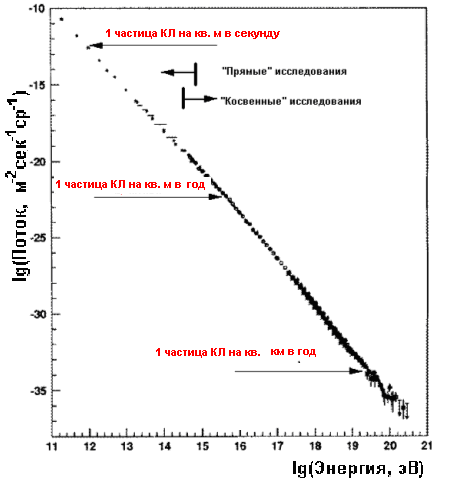
This is how looks like the CR spectrum in the double logarithmic scale.
How the galactic cosmic rays born
For more than half a century there have been various hypotheses about the CR born and its acceleration to such high energies, as the best laboratory accelerators on earth dispersed particles only to the energy of 1012 eV order. As it mentioned above, the first attempts to explain the origin of the CR were based precisely on energy estimates. First of all, it was necessary to find astronomical objects, which power of released energy could be responsible for the full CR energy, accumulated at present in the Galaxy, and supporting more or less constant CR density over the time. Flashes of Supernovae (SN) may be objects like this.
Another ancient annals and chronicles reported that stars with exceptionally very high brightness had suddenly appeared once in a way. They had increased brightness quickly and then slowly faded away and ceased to be visible for a few months. These stars were visible even in the daytime at the maximum of brightness. The brightest flashes were recorded in 1006 and 1054 years. Information about that flashes contained in Chinese and Japanese treatises.
Suchlike star burst in the constellation of Cassiopeia in 1572. It was observed by outstanding astronomer Tyge Brahe. And a similar flash had been seen by Johannes Kepler in the constellation of Ophiuchus in 1604. Since then, in a period of four centuries of "telescopic" era in astronomy, any flashes alike in our sector of the galaxy was not observed. However, with the development of observational astronomy, scientists were able to detect outbreaks of supernovae in other galaxies. And now, it’s well known both frequency of SN explosions and details of the explosions. SN outbreak in 1987 has been met with a full astronomical knowledge. It occurred not far from our galaxy in the Large Magellanic Cloud. Even the outbreak of expected neutrino radiation of this SN was registered. Next figure shows how the star was looked before and after explosion.
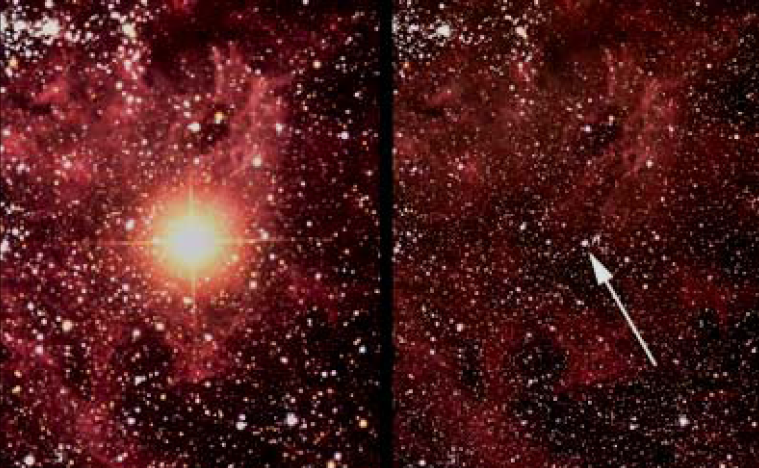
The famous supernova of 1987 before (on the right) and after (on the left) flash.
Supernova outbreak - it's not the birth. Conversely, it’s the end of evolution of massive star with a mass in 8-10 times exceeds the mass of the sun. The energy of SN explosion, transmitted to the shell and reset during the explosion, is currently estimated as 1051 erg. But it is not inconceivable that there are dozens of more energetic explosions. They got the name Hypernova. The energy, freed in supernova explosion, is more than enough to dissipate completely the stellar matter in the space. After the explosion, the star has ceased to exist in its prior form. And if we assume that a few percent of its kinetic energy goes to accelerate the nuclei and the electrons, that frequency of SN explosions once in 30-50 years, supernovae can provide the observed density of CR energy in our Galaxy. Exactly this assessment was one of the reasons allowed to view SN as the main source of CL in the galaxy for the past decades.
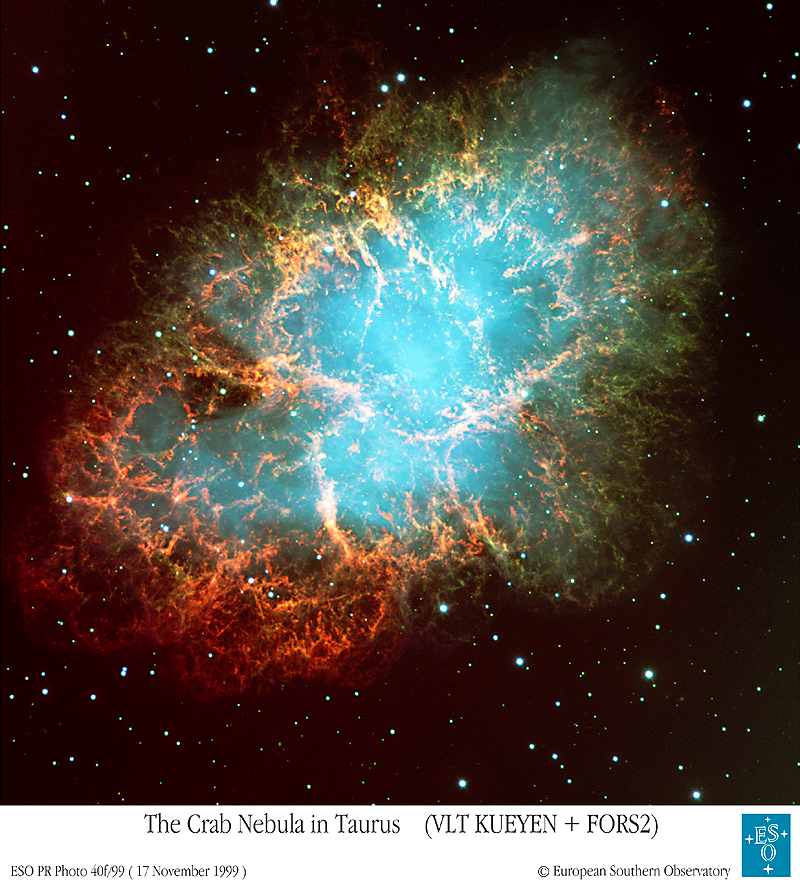
Discarded shell of Supernova of II type that exploded in 1054. The Crab Nebula.
Star shell, jettisonable with a great velocity, called a supernova remnant – SNR (R means remnant in English). And a compact remnant remains after the explosion in most of supernovae. It is rotating neutron star, emitting radio waves at a frequency ranging from split second to 3.2 seconds, which can be detected by astronomers as a pulsar. For example, there is a pulsar in the center of the Crab Nebula, pictured above. But a pulsar in the supernova of 1987 can not be seen. Scientists theorize that if a very massive star with a mass more than 20 solar masses bursts, not a neutron star but a black hole may occur in the center. It was shown in many studies that particles were very efficiently accelerated in the magnetospheres of pulsar. The neutron star with a high magnetic field, as a rapidly rotating, generates enormous difference of potentials on the surface and in the magnetosphere. This difference creates conditions for the acceleration of particles to energies of 1012-1013 eV. Nevertheless, the most probable mechanism of acceleration of CR is considered the acceleration of shock waves in supernova shells.
The expanding shell collects and compresses the gas surrounding it. The shock wave occurs as the explosion of the atomic bomb, only in the billions and billions times stronger. According to modern concepts, the most probable mechanism of acceleration of the GCR to thermal energies up to 1015 eV is the statistical acceleration of particles in the shock waves of SNR. The essence of this mechanism (proposed by the American physicist E.Fermi) is that there is the multiple collisions of charged particle with a moving magnetized clouds, and in the average the energy of particle increases in each collision increases. If these magnetic inhomogeneities move in the same direction, the increase of energy is happening so fast that it is sufficient to explain the energy spectrum of the GCR. It seems, just such a situation has formed around the front of SN shock wave, where magnetic inhomogeneities (plasma turbulence) exist on both sides of the front. The particles of interstellar matter, trapped in the process of acceleration, cross the shock front many times under the influence of a magnetic field, and gaining additional energy with each intersection. This is a statistical process. Therefore, particles can leave the acceleration region in each cycle with a certain probability. It explains why the number of particles with small energies is much more than particles with high energies. Consequently, there is a power-law distribution of energy.
The picture shows a clipped cone of shock wave, from which cosmic rays fly like cosmic bullets. However, the particles at very high energies hardly unfolds a magnetic field. And when the radius of slew trajectory of a charged particle, under the influence of a certain magnetic field, becomes comparable to the radius of the shock wave, particles finally leave it and stop accelerating. It is the natural boundary of the acceleration. In recent years, the idea about CR has been proposed. It says that cosmic rays, hesitated around the shock front, like a stream of charged particles, can generate additional magnetic fields themselves in tens or hundreds times greater than the average magnetic field in the medium. And such fields on the edge of expanding shells of supernova actually observed by astronomers. Due to this effect, particles can be held around the shock front, even with the energy of 1015 eV, ie, reaching the energy close to the knee area in the GCR spectrum. The issue of GCR acceleration to higher energies remains uncovered and causes sharp discussions.
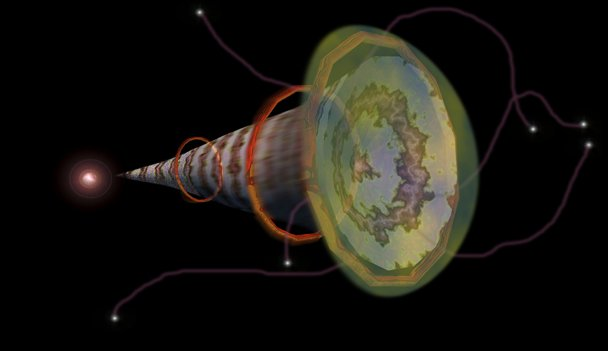
Flying off particles in all directions from the SN of the shock wave was called “cosmic bullets” by authors of illustration of the CR acceleration mechanism, employees of Goddard Space Flight Center
Where the heavy elements of CR come from
It is known, the space environment consists essentially of protons. The impurity of elements in the universe is very small. The share, attributable to the heavy elements, is only 0.01-0.5% on the periphery of the Galaxy. There is a process of star formation in the thin disk of the galaxy, where is the epicenter of Supernovae, and it is no more than about 2-3%. And this ratio is significantly greater in cosmic rays. The number of nucleus is comparable to the number of protons at a fixed energy per particle. Typically, the representation of the chemical elements in the CR compare with their representation in the solar system. This comparison is shown in the figure below.
Where do the heavy elements come from? Except the light elements 1,2H, 3,4He, 7Li, formed during the formation of the universe in the Big Bang, all the elements in the universe up to iron are formed in processes of stellar evolution at combustion and fusion of light elements. There is an ongoing process of nucleosynthesis during the evolution of a star in all its stages (light nucleus fuse into heavier during thermonuclear reactions inside stars with the release of energy, providing the luminosity of the star). Due to the gravitational forces, the plasma in the inner of stars has a huge temperature and it is sufficient for the synthesis of heavy elements.
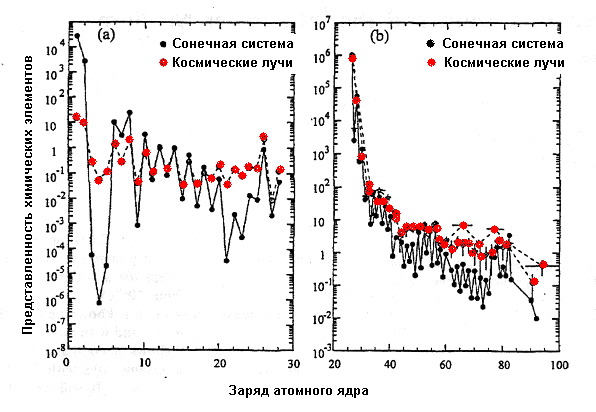
The representation of nucleus with different charges in cosmic rays relatively its representation in the solar system.
The intensity of nucleus set to 1 for silicon on the left figure and 106 for the iron cores on the right figure.
The star with a mass greater than 8 solar masses looks like a bulb at the end of its evolution (as it shown in the figure). There are a lot of heavy elements up to iron nucleus inside it. The energy, released in the process of nucleosynthesis, can not withstand the forces of compression. The star collapses. The formed elements thrown out the environment and dispersed therein. So you can be sure that all the nucleus heavier than carbon, which exist in the world, have passed through a thermonuclear furnace of a star. And only after that our star - the Sun and planets had formed, from the interstellar gas at the gravitational compression. Thus, there is a constant cycle of gas-stars-gas, in which the surrounding interstellar medium “becomes heavier” over time, and pulled together to the disk of the galaxy under the force of gravity.
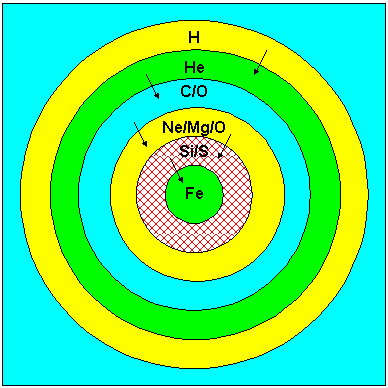
The chemical structure of the supergiant before the explosion of supernova of the II type.
The formation of heavy elements with nuclear charge above Z = 26 (iron) takes place in more exotic furnaces than thermonuclear. According to modern concepts, they can be formed as a result of neutron capture, which is possible at high densities of neutron only and at very high temperature conditions. Such conditions could be achieved in the moment of supernova explosion of the ll type (neutron star formed in the result of explosion of supernova) or in the moment of the merger of two neutron stars, when a large number of neutrons at high temperature concentrates in the ejection.
However, not the whole elements can be born with equal probability in the course of nucleosynthesis. The probability of formation of such elements as Li, Be, B, Sc, Ti, V, Cr, Mn in thermonuclear reactions is low, by the law of nuclear physics. These elements are formed mainly in the processes of nuclear reactions of heavier cores with nucleus of the interstellar medium, i.e. they are fragments of heavier nucleus. Therefore, it’s accepted to name them secondary nuclei. The number of such nucleus of GCR is greater in orders of magnitude than in the average interstellar medium, as its seen in the figure. As it will be shown below, the study of the share of secondary nuclei is a powerful tool for studying the processes of GCR distribution in the galaxy.
ВDuring the explosion the expanding shell compress the gas surrounding the star. And a certain share of gas particles involves in the process of acceleration. It is therefore considered that the composition of the CR in the sources repeats the composition of the middle interstellar medium. In fact, the share of protons and helium is far less in CR than in the middle interstellar medium. There is one of explanations for this fact. The medium surrounding supernova before explosion is already enriched by heavy elements through the so-called stellar wind, which is a relatively slow leakage of the shell of a massive star in the surrounding space. In addition, cosmic dust particles, which holds much of the heavy refractory elements, can be effectively involved in the acceleration process at the initial stage. However, dust particles collapse, reaching the high energies. But the share of heavy elements increases, compared to light elements, as a result of such process. So, the number of dust particles in GCR is significantly greater than in the medium. The studying of representation of different chemical elements in GCR can confirm or refuted this hypothesis.
Well, if acceleration occurs in magnetospheres of pulsar, particles injected from the surface of pulsar, can be radically different in composition from the middle interstellar medium. For example, some work suggests that it may be a helium nucleus, or even just the iron core. Therefore, the study of chemical composition of cosmic radiation in different energy ranges can provide a serious indication of the place where the GCR accelerated.
The spread of cosmic rays in the Galaxy
The charged particles of GCR fall under the influence of galactic magnetic fields leaving the shock front. There is a mutual influence of magnetic field and a stream of charged particles. The particles change its original path ("entangled" in the magnetic fields of the galaxy), and can get out of it, reaching the edge of the galaxy ("expire" from the Galaxy). Moreover, the process of "expire" depends on the energy of the GCR particles. This is due to the fact that, the more the energy of the particle, the harder it is to deploy a magnetic field, i.e, the radius of curvature of its trajectory increases, and particles virtually fly in a straight line at the energy of 1019 eV. It means that the probability of particle escape from the galaxy rise with energy increasing. The distribution of cosmic rays is diffuse in nature, so this behavior is mathematically described as the dependence of the diffusion coefficient from D ~ Ea energy, where the exponent is a = 0.3-0.6. Solving the diffusion equation, we find that the energy spectrum of particles becomes steeper just by the value of a, as diffusion to the Earth. Therefore, the average spectrum in the I ~ E -2.1-2.4 sources is estimated by the I ~ E-2.7 measured spectrum near the Earth.
Time of retention or "lifetime" of the GCR before the escape beyond the boundaries of the galaxy is inversely proportional to the diffusion coefficient, i.e, it decreases with energy increasing. It is about 40 million years for particles with 2.1 GeV energy. They have time to fill the galactic halo during this time. And although the matter in the Galaxy is basically very rarefied (10-3-1 atoms / cm3), they also have time to go through the observable thickness of material about 10 g / cm2 (the path is very often expressed in units of density/distance in nuclear physics, therefore it has the dimension g / cm2). The passed path must decrease sharply for high-energy particles (it is now only 0.1-0.4 g / cm2 at an 10 TeV energy, and the "lifetime" of the GCR at these energies is already 1-3 million years.

Now It is known that cosmic rays fill the extended halo of the galaxy,
although the basic objects that can accelerate the CR, are in disk component of the Galaxy.
Whether the passed path decreases in fact, it can be found by measuring the proportion of secondary nucleus at high energies, as it is directly proportional to the length of the path (expressed in g / cm2), traveled by the particle. The figure below provides a picture of the share of secondary nucleus of boron to the primary carbon nucleus and its extrapolation to higher energies for the different models. All models match up with the experimental data quite well, as it shown in the figure. But the ratio of secondary to primary nucleus can differ by two orders of magnitude in different models, even at 10 TeV energy. By measuring this ratio at high energies, we can determine the value of the diffusion coefficient. And it means that we can to conclude the spectrum of turbulent magnetic fields of the galaxy, and learn how to move from the observed spectrum to the spectrum in sources.
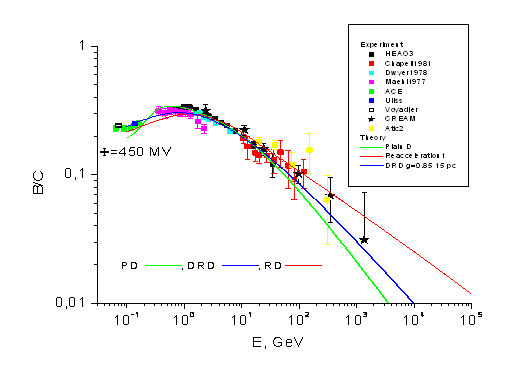
Current B/C data with predictions of different models.
Anisotropy problem
It has been far observed that the GCR fall to Earth surprisingly isotropic. There is a small overflow of GCR in the same direction at the level of 0.04%. It is explained by the movement of the Earth towards the GCR (The Compton–Getting effect). The problem is that, anisotropy must increase with the rise of energy as the diffusion coefficient, i.e. A ~ E0.3-0.5, in accordance with calculations. But it’s virtually does not depend on energy up to 100 TeV. In addition, in the standard theory of CR acceleration in supernova remnants, similar remnants, such as SNR Vela, must give a significant contribution to the GCR flow. And the excess of particles from this direction should be observed. The measurement of anisotropy on the Earth have carried on the surface facilities for secondary particles, formed in the atmosphere. That’s why it has formed without determination of particle kind. The task has turned up difficult, not only because of the smallness of the anisotropy, but also because of different effects in the atmosphere, leading to a change of secondary particle streams. In addition, any ground installation scans a limited part of the sky. Therefore, in order to answer the question whether cosmic rays are formed in different sources, it is necessary to measure the anisotropy for different nuclear component, and it is better to measure it beyond the atmosphere around the sky for a few years. The small size and the absence of the energy dependence of the anisotropy from the energy indicates either a much weaker growth of the diffusion coefficient with increase of energy, connected with the GCR spread, or a much larger number of CR sources that contribute to the main stream than supernova remnants.